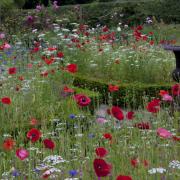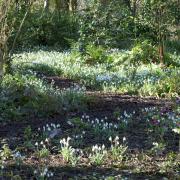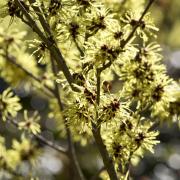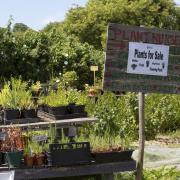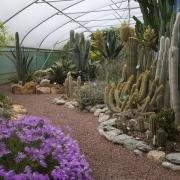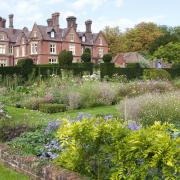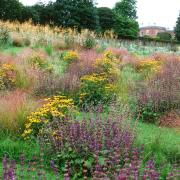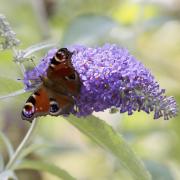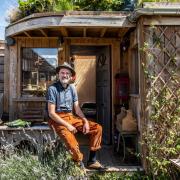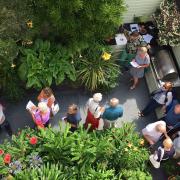You can’t fail to come under the spell of the gardens at Scotney Castle, especially in spring when the scene is of wisteria draped arches and swathes of rhododendrons clad in bloom

Scotney Castle near Lamberhurst draws visitors for its magical gardens that stretch down a slope to a 14th-century moated manor house, Scotney Old Castle.
The scene is aptly described on the website: ‘the garden has naturalistic planting which is seemingly untouched by human hands and its cloud-like planting of rhododendrons and azaleas creates a fairytale feel, with the ruins of the Old Castle at its centre.’
It is indeed like a series of paintings as you look at the vignettes that have been created in the 18th-century ‘picturesque’ style, with the atmospheric ruins and watery reflections the highlights of your visit.
“The picturesque style encompasses the rough and natural landscape around the garden and wider estate and some of the original elements of the landscape from when it was laid out in 1870 include the quarry, the ruined Old Castle, some of the original Ghent azaleas and rhododendrons, and larger trees that were used to frame many of the views and vistas,” explains Garden and Estate Manager, Paul Micklewright.

“The quarry was created for a dual purpose, one to provide some of the sandstone for the new house and secondly to create a rugged landscape with exposed rock faces and rhododendron around the top of this.
“The old castle was deliberately ruined to create a picturesque feature at the bottom of the garden with the new house looking down on it. Old ruined buildings were a major feature of a picturesque landscape and the Old Castle suits the garden at Scotney perfectly,”
With such a long history, the garden has evolved over time, retaining and enhancing the elements. Lanning Roper, the American garden designer and friend of the Hussey family, who owned the estate before it was given to the National Trust, created several designs for the beds around the old castle and along the Top Walk which heads down towards the Ice House.
“Some of these designs were implemented4 and exist in the garden today,” adds Paul. “Since 1970, when the National Trust took over the management of the garden, planting schemes have evolved and changed, particularly after the 1987 storms.

“Areas of large rhododendron ponticum have been cut back and in some cases cleared, and more recently winter-interest plants, such as cornus, salix and witch hazels, have been incorporated into the planting schemes to offer a more year-round offer for our members. We are also planting more spring bulbs such as snowdrops and older Victorian species of daffodils to add a splash of colour.”
Some particularly stunning spring plants to look out for include rhododendron ‘Mrs G.W Leek’, a large, pink-flowering shrub at the top of the garden on the way to the Old Castle; a magnificent magnolia x loebneri ‘Leonard Messel’ by the ha-ha which has fragrant lilac-pink flowers, and the breathtaking wisteria chinensis which clothes the Old Castle.
Wandering down to the bottom of the quarry you can admire the Ghent azaleas that have a beautiful sweet scent with yellow, salmon blooms and are part of the original planting scheme from the late 1870s onwards.
“Scotney is such a beautiful place, every day is different. There is something for everyone. I think the different aspects of the garden also appeal to everybody with more formal areas around the castle and wild flower meadows on the outer edges of the garden,” says Paul.

Plant of the month
Rhododendron
• Spring flowering, woody shrub

• Woodland plants
• Showy blooms, range of colours – white, pink, purple, red, yellow, apricot
• Introduced to Britain by Victorian plant hunters from areas such as the Himalayas

Growing notes
• Dappled shade
• Sheltered from cold, dry winds
• Moist, well-drained acidic soil
• Plant April or October
• Don’t plant too deeply as that stops flowering
• Work leaf mould or compost into the planting hole
• Mulch with wood chips but avoid the stem
• Water with collected rainwater
• Ensure plenty of water in summer
• If you don’t have acidic soil there are varieties that can be grown in pots
Paul’s tips for rhododendrons
• The key to ensuring that rhododendrons are growing successfully is to keep them healthy so that they can fight off pests and disease, produce new healthy growth and an abundance of flowers
• Give them the room that they need to grow so that they have enough light and keep them pruned so that they have a healthy shape to them
• Remove any dead, dying, or damaged branches, which allows light and air around the plant, reducing the chance of pest and disease attacking the plants
Find out more
Scotney Castle, Lamberhurst TN3 8JN
Open year round (garden 10am-4pm)
www.nationaltrust.org.uk/scotney-castle
A pocket history of Scotney Castle
• Earliest occupancy 1137
• belonged to the Hussey family from 1778
• Edward Hussey III built the new Victorian mansion that overlooks the castle and estate
• The old castle was then partly dismantled and the ruin left as a garden feature
• Two more generations of the Hussey family have lived in the house
• The property was left to the National Trust in 1970
• Several apartments in the house were let out by the Trust, with tenants including Margaret Thatcher who used it as a weekend escape from her Westminster life
• Following the death of the last resident Elizabeth Hussey, the house was opened to the public in 2007
Get the look
• Create mini vignettes within the vista of your garden
• Grow a range of spring-flowering shrubs
• Infill with perennials, annuals and bulbs
• Plant in a naturalised, picturesque way
• Create an area of wildflower meadow
• Include water in the garden, whether a small water feature or a large pond with marginal plants
• Draw the eye with subtle focal points
• Place seating to enjoy views
Jobs to be done
• Deadhead daffodils as they fade, but remember to leave the foliage to die down naturally to keep the nutrients in the bulb for next year’s flowering
• Stay on top of weeds, put stakes in place for fast-growing perennials such as delphiniums and feed shrubs to give them a boost
• This is a good time to divide late-flowering perennials such as rudbeckias and asters and replant good-sized pieces
• Have a wander around your local garden centre to find some new perennials, shrubs and trees to add to your garden
• Under cover, sow crops such as celery, beans, cauliflower and broccoli, and in the open, broad beans, peas, swedes and carrots
• If you don’t have room for a veg plot use a raised bed, containers or plant some veg and fruit in your flowerbeds






